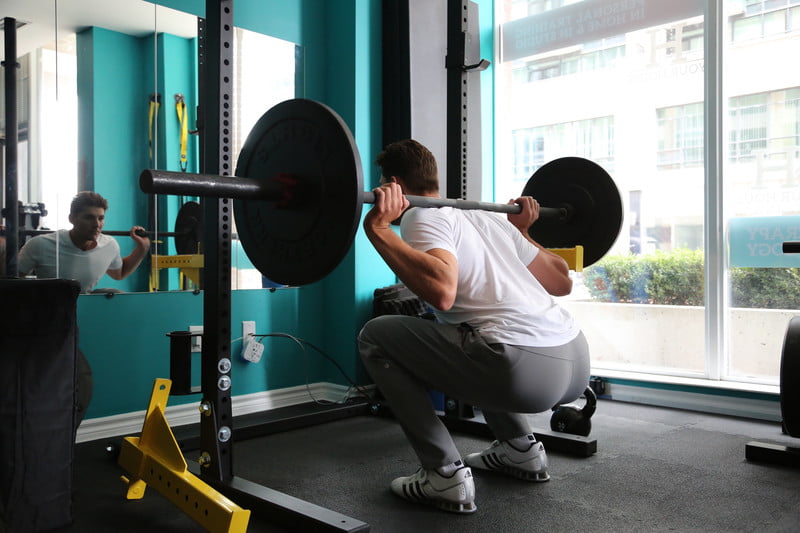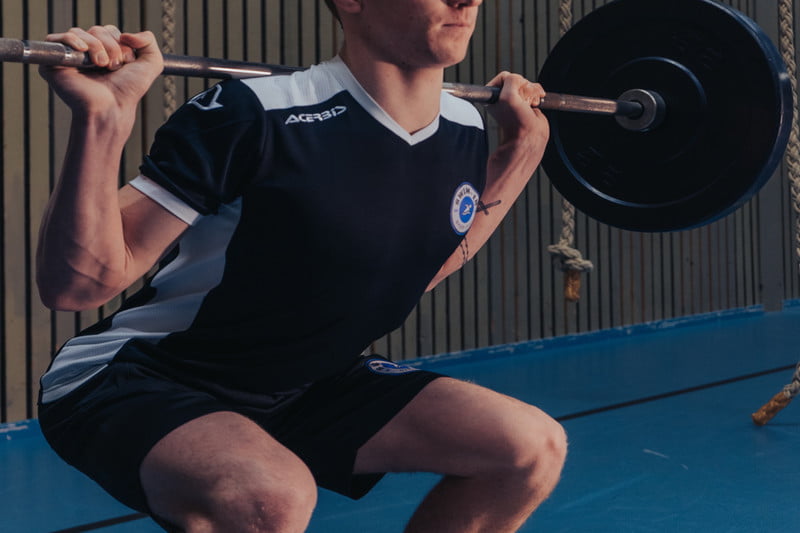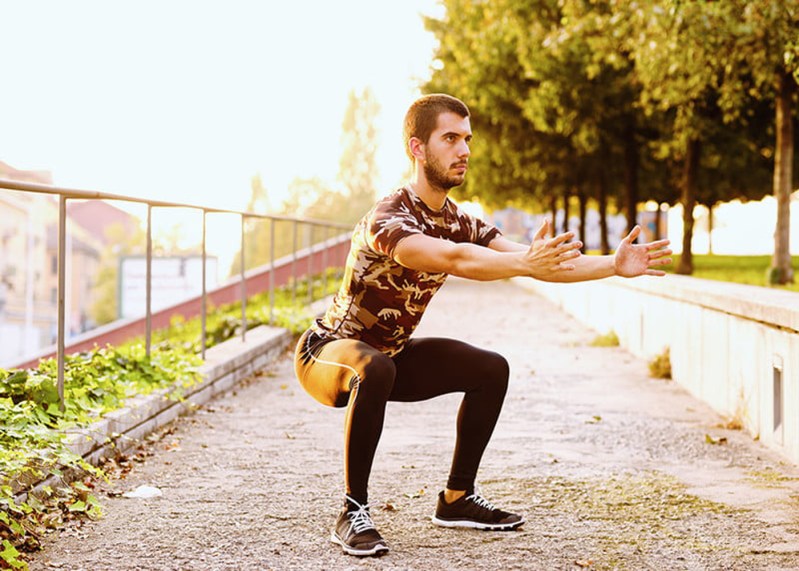
There are many benefits of squats, and they arguably involve one of the most important foundational movement patterns when it comes to strength training. Nearly every total-body or lower-body resistance-training workout will include a variation of a squat due to its effectiveness.
If you have a lot of experience in the gym or training for sports performance, you’re likely familiar with squats and how to execute them properly. But are you aware of everything a squat can actually do for you? Below, we re-introduce you to one of the most effective exercises and explain why it’s essential to appreciate and regularly perform this lower body sculpting move.

What muscles do squats use?
Ultimately, the benchmark when it comes to lower body movements, squats are highly effective exercises that engage numerous muscles throughout your body. While they primarily target the lower body muscles, they also activate several muscles above the waist when performing the squat exercises correctly, namely your core.
Main muscles targeted while squatting:
- Gluteus maximus, minimus, and medius (buttocks)
- Quadriceps (front of the thighs)
- Hamstrings (back of the thighs)
- Adductor (groin)
- Hip flexors
- Calves
Additionally, squats work your core muscles, including the rectus abdominis, obliques, transverse abdominis, and erector spinae. By engaging such a wide range of muscles, squats prove to be excellent exercises for overall strength and conditioning.

Benefits of squats
1. Squats strengthen your legs
There are many benefits of squats, and while they strengthen quite a few muscles, they primarily target the legs. Squats strengthen your glutes (butt muscles), which are essential for power, core stability, and efficient forward propulsion when running, walking, jumping, and skipping. Squats also strengthen the quads, a group of four muscles on the fronts of your thighs that control knee extension. On the backside of the legs, squats also strengthen the hamstrings and calves, both of which are instrumental in walking, running, and jumping.
2. Squats improve core strength
While squats may primarily work your legs, they also require core activation and work your glutes, hips, abs, obliques, and back extensors. In fact, studies investigating the muscle activation of various exercises demonstrated that squats actually require more involvement than planks. Having a strong core not only aids movement efficiency but also helps protect against injuries to the lower back and hips.
3. Squats increase your vertical jump
If you play sports like basketball, volleyball, or tennis, you’ll appreciate the boost your jump game gets from consistent squat workouts. The strength you’ll develop in your glutes, calves, and hamstrings from squats will help power a more explosive, impressive jumping ability.
4. Squats improve your posture
The core strengthening work — particularly along the erector spinae of the spine — from squats helps improve posture. Poor posture is associated with back pain, neck pain, sleep disturbances, and even slower metabolism. During a squat, you have to keep your back straight with your chest up while carrying the heavy load, and this is another factor that also encourages good posture outside of the gym.
5. Squats can make you a better runner
Squats improve the strength and power of your legs, which can translate to a more economical running stride and faster speeds. They can also help correct muscle imbalances created by long-distance running by requiring more glute and quad activation.
6. Squats can improve bone density
Loading your bones during squats can signal the body to increase the mineralization of your bones. Doing this also turns on key hormones that build bone rather than break it down. Bone density is particularly important as we age, so it’s certainly worth focusing on squats to delay bone loss.
7. Squats improve mobility
Squats can increase the mobility and flexibility of your ankles, hips, and knees. Including squats in your workout regimen can help you feel more limber and may protect against the risk of injuries. Squats can also improve your balance, particularly when you load on one side of the squat.
8. Squats burn calories
Like any exercise, performing squats — especially weighted squats — burns calories. Even more importantly, building lean muscle mass through exercises like squats increases your overall metabolic rate. This means that spending time in the gym getting your squats in will help you burn more calories the rest of the day (and night!) as well.
9. Squats can improve cardiovascular fitness
When performed quickly or in a circuit, squats can improve cardiovascular fitness and heart health. As a total-body movement, squats recruit nearly every major muscle in the body, especially when an external load is used. Therefore, a set of squats will get your heart pumping and lungs expanding.
10. Squats can be performed anywhere
While you might not be able to do heavy front-loaded squats at home without a squat rack, basic squats (along with many modifications) can be performed anywhere with just your body weight or minimal equipment. Whether you’re traveling and have only a small hotel room, or you want to get in a gym-free workout at home, squats are a convenient, powerful exercise move for tight spaces, limited time, and minimal equipment workouts.
11. Squats are versatile
There are so many ways to modify and alter squats to continually challenge your body and change up the muscular demand. From sumo squats and back squats to split squats and single-leg squats, you can find a different squat variety for every day of the week. Varying your squat routine keeps your muscles challenged and prevents boredom.

How to perform a squat
Here are the steps to perform a basic bodyweight squat:
- Stand with your feet slightly wider than shoulder-width apart, with your toes pointing forward, your core engaged, and your chest up and proud.
- Inhale, bend your knees, and then push your hips backward as if reaching your butt back to sit in a chair. Keep your back straight and chest up as your arms come forward in front of your body to act as a counterweight.
- Lower your body until your thighs are parallel to the floor and your knees are bent at 90 degrees.
- Exhale as you press through your heels to return to the starting position.
Squat variations to try
The world of squat exercises is vast and varied, offering tons of options to target different muscle groups, challenge yourself, and keep your workouts interesting. Here’s a glimpse into the exciting world of squat variations.
Squats by stance
- Bodyweight squat: This is the classic squat, using your body weight for resistance. It’s a great foundation for learning proper form.
- Wide stance squat: You widen your stance beyond shoulder width and emphasize your outer quads and glutes.
- Narrow stance squat: As the name suggests, you narrow your stance for a quad-focused burn.
- Sumo squat: Place your feet wider than shoulder width with your toes turned outward, working the inner thighs and glutes.
Squats with weight
- Barbell squat: This is the king of squats for some, loaded with a barbell across your back for intense lower-body training.
- Front squat: Similar to barbell squats, the front squat has you with the bar resting across your shoulders, challenging core stability and upper body strength.
- Dumbbell squat: Hold dumbbells in each hand at your sides for more freedom of movement and core engagement.
- Kettlebell squat: Grasp a kettlebell in front of your chest or overhead, adding variation and core challenge.
Squats by movement
- Jump squat: Add an explosive jump at the top of the squat for a cardio burst and power development.
- Pulse squat: Perform small up-and-down movements within the squat position for an intense burn without full reps.
- Pistol squat: This is a single-leg squat that demands extreme balance and leg strength.
- Box squat: Step onto a box at the bottom of the squat for deeper hip flexion and glute engagement.

Lower body builder
Incorporating squats into your workouts offers a multitude of benefits beyond strength and power development. When executed with proper form, this functional exercise enhances calorie burn, reduces the risk of injuries, strengthens the core muscles, and contributes to improved balance and posture. Bonus points for not having to have any equipment, too, with bodyweight squats. Squats are a highly versatile exercise that not only promotes overall strength but also provides a holistic approach to fitness and well-being.



